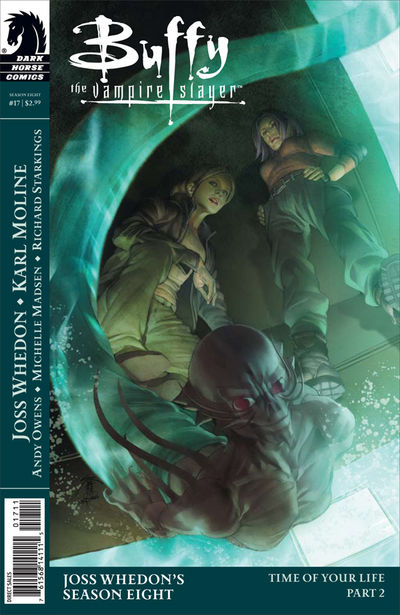Justice Society of America #18 Review
 Writer: Geoff Johns
Writer: Geoff JohnsPenciller: Dale Eaglesham
This issue continues the "One World, Under Gog" story line, but unfortunately lacks the charm or wonder of the previous issue. One major reason is that the story is told through the eyes of Hawkman, who I think was trying to come across as a tough soldier, but really came across as a dangerous psychopath. As in previous issues, the JSA are in Africa, and Gog, who last issue wiped out most of the disease in Africa, in this issue he intends to wipe out war. He focuses on fighting the Union of Congolese Patriots, an actual group well known for their use of child soldiers and killing of peacekeepers. The JSA and Gog fight them, one JSA member is killed and then Gog turns the UCP members into trees.
This is actually a very strange issue. I think the Johns is trying to say something about war, but I'm not sure what he's trying to get at, and don't like what I think I understood. First, we have a very long debate between Hawkman and Jay Garrick, in which Garrick has to stop Hawkman from killing an unconscious UCP soldier. Sorry? I find it a bit unbelievable that the JSA would include even a single member that would be capable of killing an unconscious prisoner of war. What is even more puzzling is that Garrick doesn't persuade him using the argument that prisoners of war shouldn't be executed. Instead, Garrick argues that the JSA is in Africa representing the United States, and can't be seen to be killing people. One would think that any member of an orgainisation such as the JSA would be immediately expelled if they were ever to seriously consider killing an unconscious prisoner.
The story goes on in this strange way. Eventually Gog turns the UCP soldiers into trees, which, as Superman points out, is tantamount to killing them. Rather than ask Gog to turn them back, however, Hawkman actually implicitly threatens Garrick and Scott who want to turn them back. This is bizarre. Not only is Hawkman a potential war criminal, but he is an insubordinate one. What is going on here? Then, suddenly, David Reid, the newest JSA member, yells out that the UCP soldiers are like monsters and can't be treated like everyone else, but is killed before he can kill more than a few UCP members. At that point, Gog, who seems to have the ability to resurrect people, if only as his stewards, turns him into Magog from the Kingdom Come story, only with no pants.
The debate among the JSA is so bizarre because it would seem these issues were settled years ago with the Geneva Convention. The JSA, which is supposed to be a superhero society, is seen to want to behave in ways that would have any American soldier courtmartialed. Finally, when Gog starts ending violence by turning people into trees, barely gets any sort of negative reaction from the JSA. The issue is narrated by Hawkman, who wants to kill the prisoners and cut down even the trees, who sounds only slightly less insane than Moore's Rorschach. Moreover, very little context is given as to what is a real world conflict, giving the reader no sense of why the JSA might suddenly have turned into costumed vigilantes out to kill African soldiers except that they are "the bad guys".
One serious problem here is that the sense that somehow their battle might be so desperate it warrants killing is completely undermined by the fact that they are a group of superheroes fighting a group of normal human beings. No matter how bad they might be, the JSA has already won the battle, just by showing up. They have Superman, for goodness sake, and he could just inhale and blow them all away if they wanted to. There is a complete implausibility in even calling it a war when it is superheroes against normal people. Moreover, they have a god with them who is nearly omnipotent. This isn't a war in any meaningful sense, and the JSA just comes across as killers.
Some of the ramifications of Gog's previous gifts are starting to come to light. There is a nice scene in which Damage uses a Japanese-English dictionary to ask Judomaster on a date, which he now feels he can do because his face is no longer mutilated. Doctor Midnite is realising that he has lost many of his powers when he regained his sight, and Citizen Steel is so desperate for a miracle, he has become almost oblivious to what is going on around him. These are some good character moments that recall the power of the previous issue, but ultimately, they cannot redeem it from the bizarre mess concerning the UCP.
I'm honestly not sure what happened here. When a giant million-year-old god starts rampaging about, turning people into trees, one would think the response of Earth would be to seriously worry about what he was planning to do with his power. Instead, the JSA decides to join in the killing. This is just a weird issue, and I hope it can be forgotten very quickly now that Magog has appeared on the scene.
C+
Labels: Justice Society of America


















